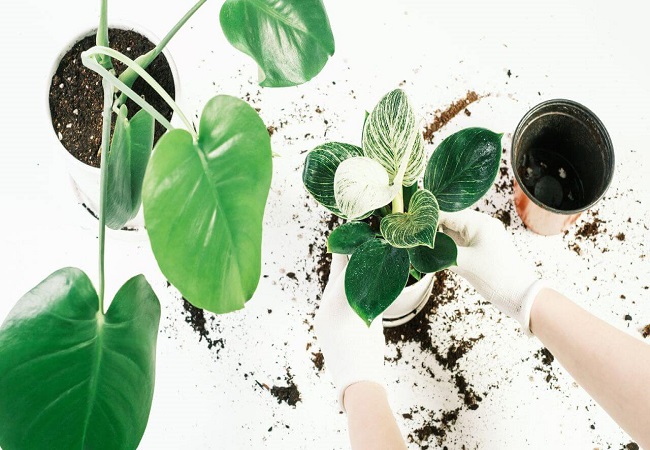Last Updated on May 16, 2023 by Md Deloar Hossain
A Philodendron plant during the summer months. How to transplant philodendron in summer?Philodendrons, with their lush green foliage and easygoing nature, have become a popular choice for indoor and outdoor gardens alike. However, when it comes to transplanting these tropical beauties, timing and proper technique are crucial for their well-being.
In this guide, we will walk you through the process of transplanting a Philodendron during the summer season. We’ll explore why summer can be an ideal time for this endeavor, discuss the necessary preparation steps, and provide you with practical tips to ensure a successful transplant.
Whether you’re a seasoned gardener looking to expand your green oasis or a beginner eager to nurture your first Philodendron, this guide will equip you with the knowledge you need to confidently undertake this exciting project.
Quick Navigation
What Do You Need To Know Before Transplanting?
Before you start the transplanting process, you must know the plant species and the exact cultivar or variation. Using this information, you can figure out the best time of year to transplant and the best way to do it. It is also essential to have a good understanding of the plant’s root structure.
This will assist you in determining the most effective method to dig up the plant and the proper method to replant it. Last but not least, you must understand the plant’s water requirements. This will assist you in determining how frequently you need to water it and how much it will need.
How To Transplant Philodendron In Summer?
Summer is the best time to transplant Philodendron. The plants are in their active growth phase, so that they will be more forgiving of relocation. Here are some steps to transplant Philodendron in the summer:
Choose a pot 2 inches wider than the current pot: There should be enough room for the root system’s growth. Please consider the size of the plant you are transplanting and its new pot.

Prepare the soil: Soil high in organic matter will be better for your Philodendron and help promote healthy root growth. Add plenty of compost, leaf mold, or manure to the soil before adding water.

Get ready to transplant:
- Start the process by cleaning and sanitizing your equipment.
- Dig a hole that is twice as wide and twice as deep as the current pot.
- Place drainage tiles at the bottom of the hole so excess water can escape during rainstorms.
Plant the Philodendron: Put the plant in the middle of the hole and gently spread the roots over the soil’s surface with your hands. Water the Philodendron well and fertilize it as needed.

Puncture Plant Leaves with Leaf Pruners (When Necessary): Puncturing leaves allows air and water access, which helps plants get adapt quickly to their new surroundings. This is especially important when transplanting plants that are used to grow in moist soil.
Keep an eye on your transplant: Monitor its progress regularly, paying particular attention to water and fertilizer requirements. Contact a professional gardener for assistance if there are any problems, such as drooping leaves or brown patches on the soil’s surface.
Transplanting tips
Transplanting is tricky, but with a little know-how, you can succeed. Here are some tips to help you transplant your plants:
- It would help if you used a trowel or spade to avoid damaging delicate roots when transplanting.
- Use a watering can instead of your hands to give plants a gentle watering while in transit. Doing this will prevent shock and damage from occurring during the relocation process.
- Wait until transplanted plants have roots before giving them nutrients. Fertilizing transplants too early may make them weak and susceptible to disease later in their life cycle.
- Make sure the new soil is evenly moist before planting: A dry transplant will not establish well.
How To Care For Philodendron In The Summer Months?
Summertime is a great time to transplant philodendrons! Philodendrons are hardy plants that can handle hot, humid weather, so long as they are given the right care.
The following are a few summer philodendron care tips:
- Water your Philodendron regularly. Keep its soil moist but not soggy.
- Avoid direct sunlight or heat during the hottest parts of the day.
- To avoid burning the leaves on your Philodendron, place it in a shady spot or cover it with a cloth if it gets too much sun or heat.
- Mist your Philodendron occasionally to keep its leaves moist and cool down from the sun’s heat or air conditioning on a hot day.
- Fertilize your Philodendron sparingly during the summer months with a high-nitrogen fertilizer designed for flowering plants. Do not fertilize regularly to prevent overgrowth and root damage from too much nitrogen fertilizer use.
- Prune back branches that get too long or thick to promote airflow and prevent overheating; thin out any crowded branches to allow more light to reach the leaves.
- If your Philodendron begins to show signs of stress, such as wilting leaves or yellowing foliage, it may need to be replaced. Even if you have to replace your Philodendron in the summer, don’t worry; it will recover with a little extra care.
Frequently Asked Questions
Can Philodendron Grow Outside In Summer?
Some species of Philodendron are tropical plants and cannot survive in temperatures below 50 degrees Fahrenheit. Other species of Philodendron can tolerate lower temperatures, but they may not grow as well outside in summer. It is best to research the specific Philodendron species before deciding whether it is grown outside in summer.
How Hot Is Too Hot For A Philodendron?
The ideal temperature range for a philodendron is between 68-77 degrees Fahrenheit. When the temperature exceeds 86 degrees, the plant will experience heat stress. If the temperature exceeds 95 degrees, the plant could die.
Do Philodendrons Like Sun Or Shade?
Philodendrons are a type of plant found in shaded and sunny environments. They prefer moist soil and high humidity but can adapt to various conditions. Sunlight is not necessary for philodendrons to grow, but they will typically become darker and less lush in shady areas.
Conclusion
Transplanting a Philodendron in the summer can be a rewarding and fulfilling experience for any gardener. By following the right steps and considering the specific needs of your Philodendron, you can ensure a successful transplant and help your plant thrive in its new environment.
Throughout this guide, we have explored the reasons why summer is an opportune time for transplanting Philodendrons. The warm weather and longer days provide optimal conditions for root development and establishment, allowing the plant to adapt and grow vigorously. We have also discussed the importance of proper preparation, including selecting the right pot, soil, and location, as well as ensuring adequate watering and care after the transplant.

I’m Md. Mahfuz Anam always enjoys taking care of plants and gardening. I find it therapeutic and a great way to relax. I have also always been interested in learning about different types of plants and how to care for them.


